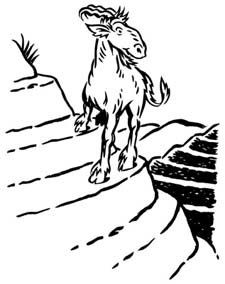Sidehill Gougers are fictional creatures, said to inhabit the Rocky Mountains of British Columbia and the southwestern sandhills of Saskatchewan. The legs on one side of their body are longer than the legs on the other, allowing them to stand comfortably on sloped terrain.
Also called sidehill badger, sidehill winder, sidehill dodger, sidehill wowser, godaphro, and gyascutus.
Description/Morphology
Beyond the unusual length of the gouger's legs, little is known about the appearance of this creature. All sources agree that the Sidehill Gouger is herbivorous and quite timid. Some say it's badger-like. Some say it's goat-like. One observer, a Harry S. Knight of Camp Wood, Arizona, has been quoted as saying: "A Sidehill Gouger is jest a burrowin' buffalo, sized down and growed crooked.". Some sources indicate that they are no larger than mountain goats, whereas others attribute major landslides to Sidehill Gougers that become turned around from their usual orientation and dig their feet into the ground for stability. It is this belief that gives the species its name.
Clockwise and counterclockwise Gougers
Sidehill Gougers are said to come in two main varieties, the left-handed Sidehill Gouger and the right-handed Sidehill Gouger. The two varieties are sometimes known as clockwise and counterclockwise Gougers.
Note that these two varieties are not necessarily separate species; stories persist of rare offspring between left-handed and right-handed Gougers. Right-handed and left-handed gougers, it should be noted, are simply different forms of the same species and can breed together. However, their offspring often end up with mismatched legs (a long leg on their front left and a second long leg on their back right, for instance) making it almost impossible for them to move. Such hybrids usually don't survive long.
Family
References to sidehill-type creatures can be found in records dating back hundreds of years. Sir Thomas Browne, writing in the 17th century, recorded a popular belief that British badgers (popularly referred to back then as "brocks") had legs of different lengths: "That a Brock or Badger hath the legs on one side shorter then of the other [which] though an opinion perhaps not very ancient, is yet very general; received not only by Theorists and unexperienced believers, but assented unto by most who have the opportunity to behold and hunt them daily." (Pseudodoxia Epidemica, 1646, Book III, Chapter 5, 'Of the Badger').
The notion of imaginary animals with one pair of legs longer than the other in order to exist on mountainsides is popular: others include the Scottish Wild Haggis, the Sidehill Dodge Hodag, the French Dahu, the Rackabore. A similar creature in Vermont is known as the Wampahoofus. Similar animals are part of Appalachian folklore, sometimes in the form of a breed of cow with mismatched legs.
See also
Resources
- Cox, William T.; Illustrated by Coert Du Bois. With Latin Classifications by George B. Sudworth (1910). Fearsome Creatures of the Lumberwoods- With a Few Desert and Mountain Beasts. Washington, D.C.: Press of Judd & Detweiler Inc.
- Dill, Lawrence M. (1983). "Behavioral Genetics of the Sidehill Gouger", in George H. Scherr, editor; Richard Liebmann-Smith, associate editor: The Best of the Journal of Irreproducible Results. New York: Workman, 9-10. ISBN 0-89480-595-9.

